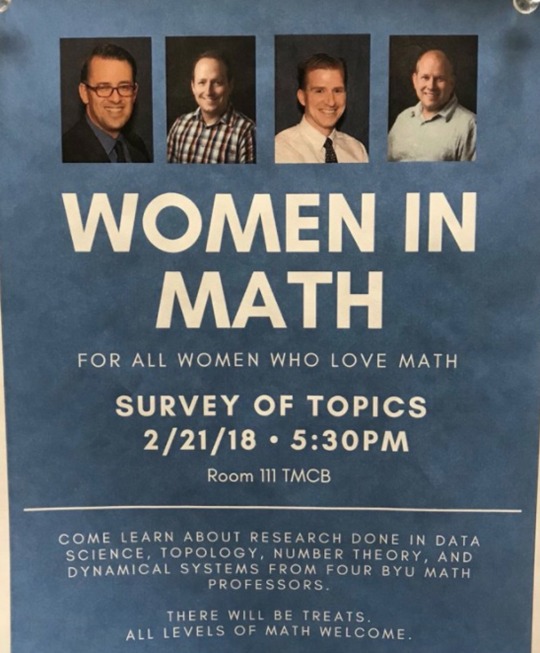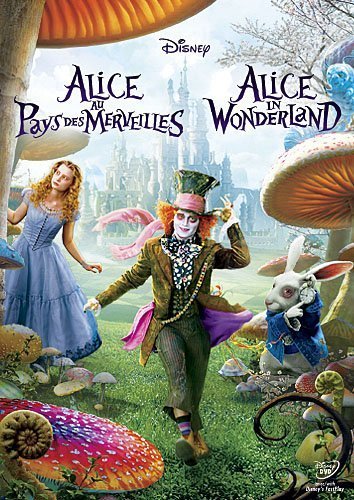Don't wanna be here? Send us removal request.
Text
How to Create a Graphic Without Pissing off the Internet
0 notes
Text
One Small Flaw
A math organization at Brigham Young University managed to make the entire internet go crazy with one picture. BYU's Women in Math organization just wanted to advertise an event, but they had a large flaw in their poster design, for an event called "Women In Math" they had all men pictured and it caused an outrage among viewers. This advertisement can be shown in figure 1.

This can be prevented easily by using some more technical steps within the graphic design process of creating an advertisement. The men showed in BYU's Women in Math poster were other facility members that were to attend the event but, to others, they thought of things from the organization making a satire to just being sexist. This is an example of why knowing how to effectively make an advertisement through graphic design is so important to making a successful event.
0 notes
Text
Defining Graphic Design and Recursive Logic
Defining Graphic Design and Recursive Logic
Graphic design is where someone "may use a combination of typography, visual arts and page layout techniques to produce a final result". One way you can make this more successful is by incorporating recursive logic within the graphic design process. Recursive logic "is used to define the elements in a set in terms of other elements in the set". To better explain this, see figure 2 below.

Not looking at the flaws in this advertisement, the overall point of this advertisement is about an event. Each part of the advertisement relates to others, such as how the date and time of the event relate with the name and what the event is because that is what the event is about and it where is being held. The people that will be there also relate to what time and where they will be for what event. The overall advertisement itself is a graphic design and together they can help create a more effective even without confusing the audience and getting the point across while giving a good amount of information about the event.
0 notes
Text
Example of Graphic Design Though Tim Burton's Alice in Wonderland
As an example, when the designer of Tim Burton’s remake of Disney's Alice In Wonderland was told to make a movie poster, they were given certain requirements that had to be included on the graphic like the name, release date, director, the company who is filming the movie, and so on. The designer then brainstorms ideas of what fonts and pictures to put on the graphic. Once the designer creates the plan for the graphic they start to put it together. They choose things like fonts, pictures, and decide where to place things that will draw attention to the poster and give the important information while also making the viewer interested. Two of the graphics that were made for Tim Burton’s remake of Disney's Alice In Wonderland is shown in the figures below


The overall plot of the movie as told by IMDb, a movie information site, is about a nineteen-year-old girl going to a fantasy land that reminds her of “nightmares” she had as a child. She is then challenged with the task of restoring the good in the land and taking down the evil queen of hearts. This movie includes talking animals and other inanimate objects along with exaggerated sizes of plants and other background objects. Since this is more of a silly, fantasy-themed movie with a bit of a dark side the designer used a font to show this while also using the background and the appearance of the characters. In the original movie poster, they used things that would draw in the audience like displaying an actor and director who is well known and loved. All of these things relate to one another as explained before. This overall contributes to creating a successful graphic.
0 notes
Text
How they work together to create a graphic
Something that makes graphic design and recursive logic work well together is by incorporating the Recursive Object Model, or ROM, designed by Yong Zeng into the process. This is explained in Jinsong Yua and Shengli Chen's article "Validation of Recursive Logic in Graphic Design" as "a conceptual tool representing objects and their relationships..." "...which can be used to represent and explain design activities." This overall process teaches that from trying to get to the design requirement you must go through multiple steps as said by the creator Zeng. If you were required to create a graphic about the fairytale Hansel and Gretel this could be an example of the process. First, you are given an overall goal to meet, for this example, I chose to create a graphic about the fairytale Hansel and Gretel. After stating this there is then an analysis of the main parts of the story, which are the kids, the candy house they found after being abandoned, and the witch who tries to cook them. After this, you then use the ideas to create the graphic. The normal house is turned into a candy house. After this, I placed a shadow of the witch inside the house and after that to create the final piece I placed Hansel and Gretel in front of the shadow. This process can be visually explained in the figure below.

0 notes
Text
Creating your Graphic while Using Recursive Logic.
Relating back to BYU's Women in Math poster, a small change that could have been made to better this poster is by lowering where the pictures of the men are and also putting how they relate to the event. Putting something like "meet these facility members you may not know" or another quote along the same concept would help the viewer understand how the men pictured relate to the rest of the poster. What you want to do is make sure every bit of the graphic you create relates to the other parts of the graphic and are explained to make sure there are no miscommunications. Simple things from even just the font of the graphic can change the audience’s entire mood towards it. Using the entire process from seeing how what parts relate to the others and organizing the different ideas along with your overall task make sure you are on track to putting the whole piece together.
0 notes
Text
Sources
Beaver, Jim. “Alice in Wonderland (2010).” IMDb, IMDb.com, www.imdb.com/title/tt1014759/.
Jinsong, Yu and Chen Shengli. "Validation of Recursive Logic in Graphic Design." Journal of Integrated Design & Process Science, vol. 21, no. 3, July 2017, pp. 71-85. EBSCOhost, doi:10.3233/jid-2016-0005.
Jorgensen, Sydney. “The Lowdown on the BYU Student-Run 'Women in Math' Club's Flier That Went Viral for All the Wrong Reasons.” DeseretNews.com, Deseret News, 23 Feb. 2018, www.deseretnews.com/article/900011224/byu-student-run-women-in-math-clubs-flier-makes-national-news.html.
“Recursive Definition.” Wikipedia, Wikimedia Foundation, 1 Mar. 2018, en.wikipedia.org/wiki/Recursive_definition.
0 notes